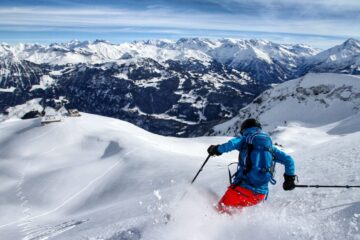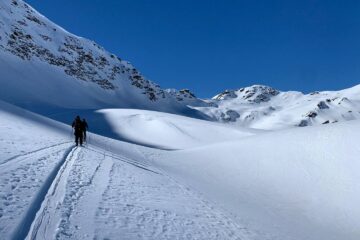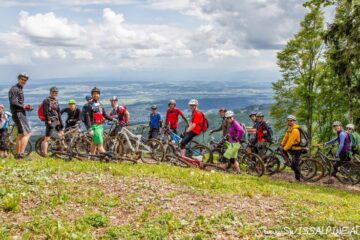In the last number of years there has been a lot of talk about Avalanche airbag rucksacks. While they have been around for about 25 years, the last few seasons has seen a huge increase in the number of options available and the number of units being sold. I predict that in the next few years the mantra of don’t go off-piste without your shovel, probe and transceiver will be changed to don’t go off-piste without your shovel, probe, transceiver and airbag.
I’m in the market for an airbag at the moment so I thought I’d lay out some of the thoughts I’ve been having regarding my next purchase.
ABS promotional video circulating on social media in the last week.
What does an airbag do?
An airbag is not a get out of jail free card. Even with one, getting caught in an avalanche is a potentially fatal experience. What an airbag does is once inflated it reduces your density so that you and the airbag will float to the top of the slide so long as it’s moving. This works in much the same way that a ping pong ball would float to the top of a bowl of sugar if you were to shake it fairly vigorously.
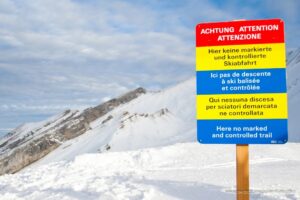 |
| Going past this sign! Do you need an airbag system? |
In general once deployed airbags will be the things that want to be float the highest in any slides, so if the airbags are on your back it is a little naive to think that the airbag will keep your head out of the snow. The likelihood is that with an airbag on your back you will come to a rest face down in the debris with the airbag itself sticking out. This means if you are unconscious you may still suffocate and you may be buried in such a way that companion rescue is still necessary. What it does mean though is that your companions will be able to find and get you out very quickly as the balloons should be clearly visible on top of the snowpack and your head shouldn’t really be much more than 50cm below the surface. This saves time when searching with a transceiver and could mean the precious minutes between life and death in an emergency.
Anyone buying an airbag also needs to be aware that it does not guaranteed that you won’t be buried out of sight. Once you enter a terrain trap of any sort the snow can pile up on top of you as the avalanche comes to a rest and then you will be buried airbag or not. I know of a few situations here in Switzerland where this happened and resulted in fatalities. This is particularly applicable if you think an airbag is something that can allow you to take more risks. For any piece of safety equipment to be effective you need to be aware of it’s limitations and not increase the danger level you put yourself in just because you have this equipment. Otherwise the extra safety you have bought yourself is negated and you may actually be in even more danger than you originally were!
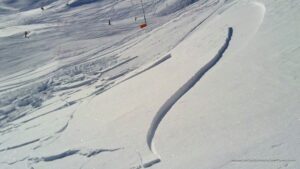 |
| A warning sign that there is cohesive snow on top of a sliding layer. |
In summary an airbag is another tool to add to your safety if the worst happens. It might help keep you a little higher up in the snowpack when an avalanche comes to a rest and it might speed up companion rescue and save precious time in an emergency. These are not guaranteed however and it should be known that the likelihood is that an airbag will not keep your head and shoulders above the debris. Hence companion rescue is still most likely going to be needed. An airbag is also not a guarantee against deep burial as soon as the terrain becomes complicated. Also remember that an airbag can only be of any use if it is inflated. There have also been a number of incidents where people have either forgotten to deploy their airbag or deployed it too late.
What models are on the market?
- ABS
- Snowpulse
- Mammut RAS
- BCA
ABS
ABS have the most experience in producing airbags of any company on the market today. Their system has been in development for over 25 years. The setup is two large bags which deploy from either side of the rucksack. This gives a small bit of redundancy if one of the bags was to become snagged and punctured. Both bags are mounted behind the torso however which may result in you laying face down in the snow as an avalanche comes to a rest. Lately ABS have been producing a base unit which consists of only the airbag and harness system and allows third party backpacks to be zipped on. The ABS system is the only one I’ve tried in the field and my complaint was always with the rucksacks themselves as they were essentially just one large compartment without pockets to store things you might need to get to quickly in external pockets. The modular system available these days allows you to put specially designed packs from DaKine, Evoc and other manufactures onto the base unit which would make for some very functional packs. Refills for the ABS system is through the purchase of a new cartridge.
Snow Pulse
Snow Pulse has now been on the market for a number of years. As far as I know they were the second company to enter the market with a novel system designed to try and make you float more head up in any snow. The original Snow Pulse airbag deployed from the top of the rucksack and formed a cushion which wrapped around the head which it was claimed could help protect from trauma to the head and neck, helped keep you head up when the slide came to a stop and as the bag deflated after the avalanche had come to a rest it also could potentially allow some breathing room. It would however reduce vision and range of motion once deployed which would only be an issue if you deployed too early or when it wasn’t needed.
Lately Snow Pulse has also developed the Removable Airbag System (RAS) system which allows the airbag to be removed and put into different sized backpacks. The RAS system goes away from the airbag shape which wraps around the head and neck to a single cushion which inflates from the top of the rucksack and sits behind the head. This system may mean the body floats a little more upright in the debris, but in my opinion once again does not ensure that you float face up when the avalanche comes to a rest. One nice feature on the newer Snow Pulse packs is how the handle packs into the shoulder strap of the bag when not in use. The Snow Pulse system has a choice of refillable or exchangeable cartridges for all their newer systems.
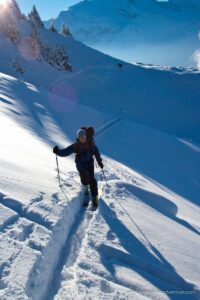 |
| Enjoying skiing away from the crowds comes with a certain element of risk. |
Mammut
Mammut is now the parent company of Snow Pulse and they produce some of their own rucksacks with the Snow Pulse RAS system. The pros and cons for the airbag system are as with the Snow Pulse RAS, but you get a Mammut rucksack which tend to have some quite nice features and I can vouch for as being comfortable and well build packs. Unfortunately for those of us that have an older Mammut pack the RAS system is not retrofitable The Mammut packs also feature a nice tidy system seen in the Snow Pulse packs to tidy the handle away into the shoulder strap when not in use. Like Snow Pulse, Mammut system has a choice of refillable or exchangeable cartridges for all their newer systems.
BCA
Back Country Access are now producing three rucksacks with their own airbag system built in. This system I’ve yet to see in real life, but it consists of a single pillow inflating from the top of the rucksack behind the head in much the same way as the Mammut/Snow Pulse RAS system. The BCA system is a refillable system that can theoretically be filled anywhere that can produce compressed air at 3000psi. This system is arguably the most straightforward one to get a refill for if the bag is ever deployed. Having not tried any BCA backpack I can’t comment about comfort or how functional the backpack is.
Which to buy?
For me there is no one system on the market at the moment that stands out above the others. Each model that I am aware of on the market has something that I like and something that I am concerned about. With the addition of third party packs to go on the ABS base unit it has become a more interesting option. I’ve used a Mammut pack myself for the last couple of seasons and found it quite comfortable and functional and I like the idea of being able to swap the airbag system between a couple of different sized rucksacks depending on if I am doing a days freeriding or going on an overnight hut tour. I also like the added potential head and neck protection of the Snow Pulse Life Bag system. But I have a very minor concern if the single airbag systems could potentially be damaged in an emergency. The single bag systems do tend to have the airbag higher up which might assist with having a head up (not face up!) orientation as a slide comes to a rest.
I think each person needs to carefully weigh up what they want from the bag before making what is quite a significant purchase. For me I am currently shifting between an ABS base system with a third party pack or the Mammut RAS.
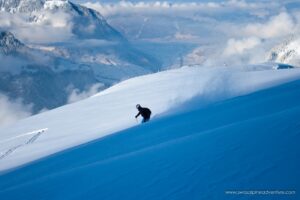 |
| The holy grail. Untouched powder shared with a few friends. |
Final Word
Remember an airbag is just another tool like your Transceiver, Shovel and Probe to improve your chances of survival if something goes wrong. It is not a guarantee that you will survive and avalanche. The best option for survival is to completely avoid getting into an avalanche in the first place. The best way to improve your chances of this is with regular training and educating yourself on mountain safety. We organise english language Avalanche Safety Courses for SAA members in December and January with qualified Swiss Mountain Guides. For more information see www.swissalpineadventure.ch
Related




